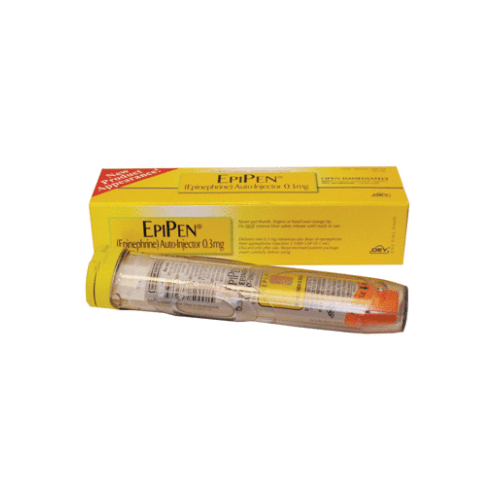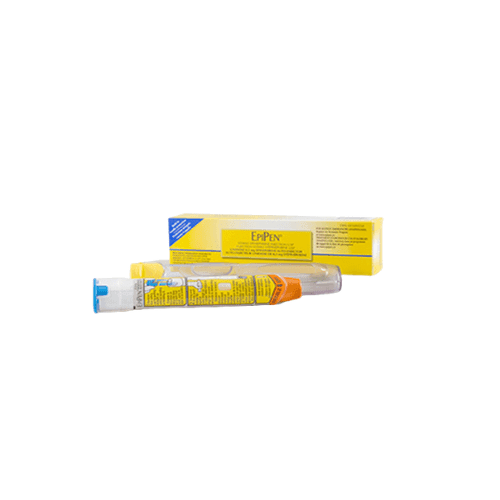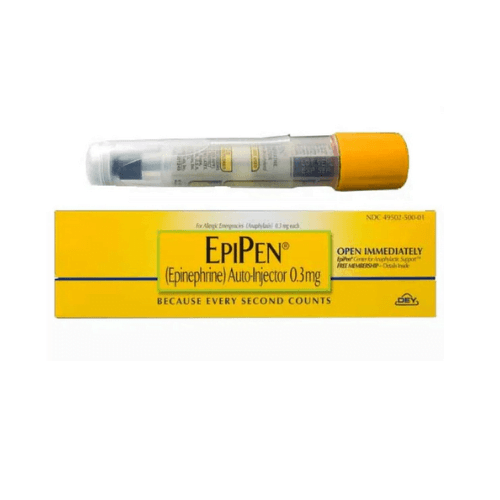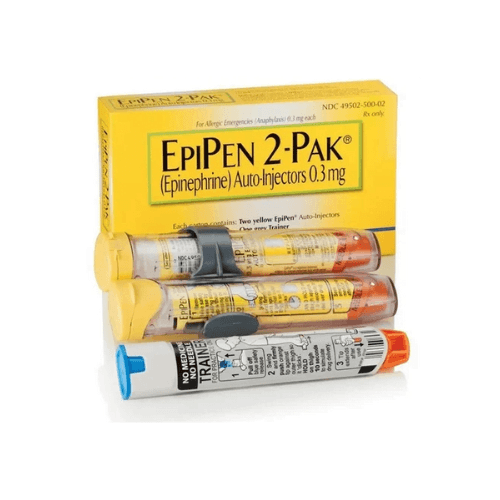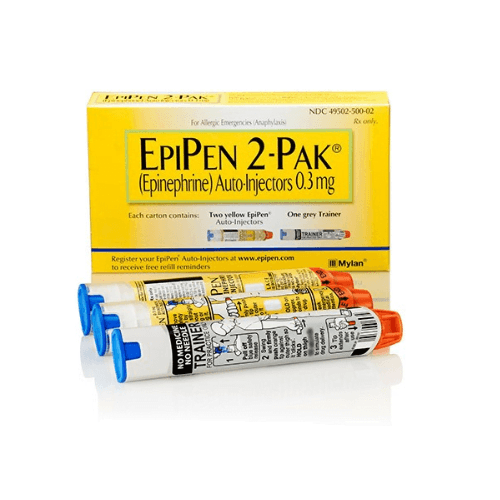Shipping with this method takes 3-5 days
EpiPen® Auto-Injector for Anaphylaxis
Stock up and Save - Get 20% off when you buy 3 or more of any one product. Use code SAVE20 at checkout.
Coupon code cannot be combined with other offers. Sale applies to all products originating from Canada. Maximum allowable quantity equal to a 90 day supply per single order.
$125.99
Secure Encrypted Payments
Epinephrine auto-injectors are used for sudden, severe allergic reactions. This page explains how the device works, who it suits, and how to use and store it safely. We also outline access options with US delivery from Canada and where to find support on refills and supplies. Many people search for EpiPen price without insurance, so we include helpful cost and access tips.
What EpiPen Is and How It Works
EpiPen® contains epinephrine, a fast-acting medicine that helps reverse life-threatening symptoms of anaphylaxis. It works by tightening blood vessels to raise blood pressure, relaxing airway muscles to improve breathing, and reducing swelling and hives. The single-use device is designed for quick, intramuscular injection through clothing if needed.
YouDrugstore is a licensed Canadian pharmacy in Manitoba. Pharmacists review prescriptions before dispensing.
When a severe reaction starts, the treatment may reduce wheeze, throat tightness, and dizziness. Effects can be brief, so emergency services should be contacted right away after use. Training with a trainer device and a written action plan can help you act quickly. Some patients carry two pens in case symptoms continue while waiting for care.
The listing may also appear as Epipen Auto Inj in some records and packaging notes.
Who It’s For
This medicine is indicated for emergency treatment of anaphylaxis caused by foods, insect stings or bites, medications, latex, or unknown triggers. It is used by adults and by children who meet weight-based criteria, as directed by a prescriber. People with a history of severe allergic reactions often carry an auto-injector at all times.
It may not be suitable for those with certain heart rhythm problems or severe coronary artery disease without careful medical guidance. The risks of untreated anaphylaxis are high, so epinephrine is generally recommended even with heart conditions when anaphylaxis is suspected. Discuss your history with a healthcare professional, especially if you take beta-blockers or have asthma.
Package options like EpiPen 2-Pak online are common so you have a backup device.
Dosage and Usage
Use this treatment at the first signs of a severe allergic reaction, according to your anaphylaxis plan. Inject into the middle of the outer thigh. Do not inject into hands, feet, buttocks, veins, or buttock muscle. After use, call emergency services and seek observation in a medical setting, as symptoms can return.
A second injection may be used if symptoms persist while waiting for emergency care, per label guidance. Keep devices together in the protective case. Practice with a trainer pen to build confidence. Read the patient insert that arrives with your device, and review steps with your clinician.
Adults and children who weigh more than the pediatric threshold are typically prescribed the 0.3 mg device. Lower-dose pens are available for smaller children, following a prescriber’s direction.
Strengths and Forms
Common presentations include:
- Single-use auto-injector designed for intramuscular administration
- Standard adult device: 0.3 mg epinephrine dose
- Lower-dose pediatric auto-injector often labeled as “Junior”
- Sold as single or 2-pack configurations, depending on market
Availability, pack sizes, and device labeling may vary by supplier and country.
Missed Dose and Timing
This medicine is used for emergencies, not on a schedule. If an injection was needed but not given, follow your action plan and seek urgent care. If symptoms continue after the first use, a second injection may be considered while awaiting medical attention, as directed on the official label. Replace used or expired devices promptly so you always have an active pen ready.
Storage and Travel Basics
Store the device at room temperature within the range described in the package insert. Do not refrigerate or freeze. Keep it in the protective case away from light and extreme heat; avoid leaving it in a car glove box. Check the viewing window periodically; the solution should be clear and colorless. Replace the pen if the solution is discolored, contains particles, or the device is damaged or expired.
For travel, carry the pen in your hand luggage. Keep it accessible, not packed away. Bring a copy of your prescription and an anaphylaxis action plan. Use a travel case to protect the device and reduce temperature exposure. Set calendar reminders to check expiry dates and to reorder ahead of time. Keep the device out of reach of children.
Pen Handling and Sharps Disposal
Practice the steps with a trainer so you understand how to remove the safety release, position the pen at the outer thigh, and press to activate. Hold in place for the period recommended in the instructions. After use, place the used device needle-first into a sharps container. Do not throw it in household trash. Your pharmacy can help with local sharps disposal guidance.
Benefits
This class can rapidly address dangerous symptoms of anaphylaxis. The auto-injector format allows quick use without measuring a dose. A protective case helps reduce damage in bags or pockets. Two-pack options make it easier to keep a spare at work, school, or during travel. Written plans and trainer devices help reinforce confidence in an emergency.
Side Effects and Safety
Common effects may include fast heartbeat, palpitations, tremor, sweating, nervousness, headache, dizziness, and nausea. Injection site pain or redness can occur. These effects are usually short-lived.
Serious risks are uncommon but can include dangerous arrhythmias, high blood pressure, stroke, or angina, especially in those with underlying heart disease. Anyone with sulfite sensitivity should review the label; some formulations contain sodium metabisulfite. The benefits of epinephrine during anaphylaxis generally outweigh these risks. Always seek emergency care after use, and show responders your action plan and used device.
Drug Interactions and Cautions
Tell your prescriber about all medicines and supplements you use. Interactions can occur with monoamine oxidase inhibitors, tricyclic antidepressants, and certain anesthetics that may increase arrhythmia risk. Beta-blockers may reduce response to epinephrine; glucagon may be considered by clinicians in that setting. Use caution if you have heart disease, hypertension, hyperthyroidism, diabetes, or Parkinson’s disease. Pregnant or breastfeeding individuals should review risks and benefits with a clinician.
Adjunctive care may include antihistamines and corticosteroids under medical supervision. For example, pharmacy items such as Benadryl, Diphenhydramine Hcl Injection, or Solu Cortef Act O Vial are sometimes used in clinical settings after epinephrine to help with persistent symptoms, but they do not replace epinephrine for anaphylaxis.
What to Expect Over Time
In most plans, the pen is carried daily, checked regularly, and replaced before expiry. You may feel a racing heart or jitteriness shortly after use; these effects tend to subside. Work with your prescriber to update your action plan after any reaction. Consider allergen avoidance strategies and education for family and coworkers. Read seasonal guidance such as Seasonal Allergies to reinforce prevention around common triggers.
Compare With Alternatives
Other epinephrine auto-injectors and prefilled options exist in some markets. Pediatric patients who meet lower weight criteria may be directed to a junior-dose auto-injector, such as EpiPen Auto Junior Inj, when appropriate. Availability varies; your prescriber can determine which device suits your needs and training.
Pricing and Access
We aim to provide transparent Canadian options for this therapy. Many shoppers look for EpiPen Canadian pricing to compare across pharmacies. You can also review epinephrine auto-injector cash price references and talk with our team about ways to streamline refills. For coupon-related information, check our current notices at Promotions. We provide US shipping from Canada on qualifying prescriptions, with encrypted checkout for your security.
If you plan to order EpiPen online, have a valid prescription ready. Our team can coordinate with your prescriber if needed. Insurance billing may differ by jurisdiction; some customers choose cash pay for simplicity. Keep a spare device on hand and monitor expiry dates so you can replace before travel or allergy seasons.
Availability and Substitutions
Stock levels can change. If a specific pack is not available, your prescriber may recommend a suitable alternative device. In many regions, an epinephrine auto-injector ships to US addresses when dispensed by our pharmacy, subject to prescription verification and import rules.
Patient Suitability and Cost-Saving Tips
Good candidates include people diagnosed with severe allergies, those with prior anaphylaxis, or individuals at significant risk of accidental exposure. People with complex cardiac histories should carry their pen but also discuss personalized risks with a clinician. Always keep devices together with your action plan.
- Multi-month supply: request a 2-pack to keep a backup nearby
- Refill reminders: set calendar alerts for expiry and reorders
- Travel packing: keep one pen with you and one in a second location
- Maintenance: check window clarity and device integrity monthly
- Budget: some pay EpiPen pay out of pocket; compare options
Questions to Ask Your Clinician
- Training plan: how will I practice with a trainer device?
- Action steps: when should I use a second injection?
- Weight-based dosing: which device strength is right for me?
- Comedications: how do my beta-blockers or antidepressants affect use?
- Follow-up: what monitoring do I need after anaphylaxis?
Authoritative Sources
Health Canada Drug Product Database
Ready to proceed? Place your request with prompt, express shipping; temperature-controlled handling when required. This information is not a substitute for medical advice. Always follow your prescriber’s instructions and the official label.
Express Shipping - from $25.00
Prices:
- Dry-Packed Products $25.00
- Cold-Packed Products $35.00
Shipping Countries:
- United States (all contiguous states**)
- Worldwide (excludes some countries***)
Standard Shipping - $15.00
Shipping with this method takes 5-10 days
Prices:
- Dry-Packed Products $15.00
- Not available for Cold-Packed products
Shipping Countries:
- United States (all contiguous states**)
- Worldwide (excludes some countries***)
How many auto-injectors should I carry?
Many clinicians advise keeping two devices together so you can give a second injection if symptoms continue while you wait for emergency care. Your personal plan may vary based on allergy history and risk of biphasic reactions. Keep devices in their case, avoid extreme temperatures, and replace them before expiry. Review your plan regularly with a healthcare professional and practice with a trainer device so you feel confident using it quickly.
Can antihistamines replace an epinephrine auto-injector?
No. Antihistamines can help hives and itching, but they do not treat airway swelling, wheeze, or dangerous blood pressure drops. Epinephrine is the first-line medicine for anaphylaxis. Antihistamines and corticosteroids are often used as add-on therapy after epinephrine, under medical supervision. Ask your prescriber which supportive medicines belong in your kit and how to use them safely alongside the auto-injector.
What if I use the pen by mistake?
Accidental injection into hands or feet can reduce blood flow and requires urgent medical attention. If this happens, call emergency services or go to the nearest emergency department. Carry your device in its protective case, keep the blue safety release on until use, and review handling steps with a trainer. If you have concerns after any injection, contact a healthcare professional promptly.
How should I store the device at work or school?
Keep the pen at room temperature in an accessible location known to coworkers or staff who are trained to assist. Avoid direct sunlight, heaters, and vehicle glove boxes. Store it in the protective case and check the solution through the viewing window for clarity. Ensure your action plan is available, and let people around you know where your device is kept and how to contact emergency services.
Do I still need emergency care after using an auto-injector?
Yes. Symptoms may return after initial improvement, so emergency evaluation is important. After using the pen, call emergency services and bring the used device and your action plan with you. Medical teams may monitor breathing, heart rhythm, and blood pressure, and provide additional treatments if needed. Discuss any side effects you felt and update your plan before you leave the facility.
Can beta-blockers affect the response to epinephrine?
They can. Beta-blockers may blunt the effect of epinephrine during anaphylaxis. Clinicians may consider additional measures in that situation. Tell your prescriber about all your medicines, including blood pressure drugs and antidepressants. Keep your action plan up to date, and ask how your comedications might change emergency steps or monitoring after a reaction.
When should children switch to an adult device?
Device selection is based on body weight and clinical judgment. Pediatric devices deliver a lower dose, while adult devices deliver a higher dose. Your child’s clinician will advise when to transition based on growth and risk factors. Keep an updated action plan at school and home, store pens properly, and practice with a trainer so caregivers know how to help in an emergency.

